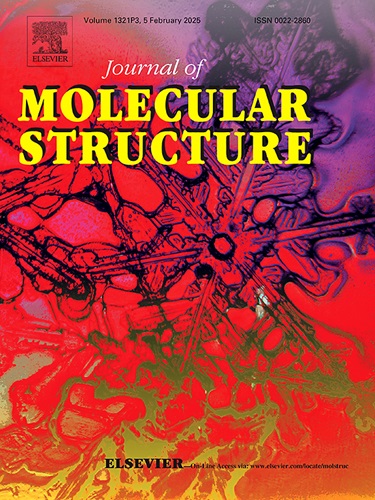Structural characterization of photoluminescent, light-driven fluorescence and phosphorescence decay properties of new azobenzene dyes containing alkoxy side chain and their DFT studies
IF 4
2区 化学
Q2 CHEMISTRY, PHYSICAL
引用次数: 0
Abstract
In the present research work, a new series of azobenzene dyes (3a-3c, 4a-4c) with terminal alkoxy side chains (butyl, pentyl, hexyl, octyl) have been synthesized and are characterized by 1HNMR (proton nuclear magnetic resonance), 13CNMR (carbon nuclear magnetic resonance), 19F-NMR (Fluorine 19 nuclear magnetic resonance), and LCMS (liquid crystal mass spectroscopy) spectroscopies. Optical studies of azobenzene dyes 3a-3c, 4a-4c revealed shift in the absorption maxima towards visible region of the spectrum and optical band gap (Eg) of 3a-3c, 4a-4c varies between 2.08 eV to 2.56 eV. Polarizing optical microscope (POM) studies revealed that the synthesized azobenzene dyes 3a-3c, 4a-4c does not possesses birefringence/liquid crystalline mesophases. The steady state photoluminescence (SSPL) studies of azobenzene dyes 3a-3c, 4a-4b unveiled sharp/broad emission peaks located at ∼ 420 nm (violet) and Eg increases with an increase in the excitation wavelengths. Room temperature photoluminescence (RTPL) studies of azobenzene dyes 3a-3c, 4a-4b displayed blue and red emission peaks at various excitation wavelengths. The fluorescence decay (FLD) studies of azobenzene dyes 3a-3c when excited at 320 nm and 375 nm unveiled slow decay characteristics and average lifetime varies between 0.037 ns to 0.124 ns. However, azobenzene dyes 4a-4b showed a comparatively faster decay profile with an average lifetime in dwell between 0.0398 ns to 0.0670 ns. Quantum yield (QY) of azobenzene dyes 3a-3c, 4a-4c increases monotonically with increase in the excitation wavelengths. The phosphorescence decay (PD) profile of azobenzene dyes 3a-3c, 4a-4b showed comparatively fast decay with average lifetime varies between 114.3 ns to 118 ns. For further investigations density functional theory (DFT) studies were employed to explain the nature of ground state photophysical properties, extensive HOMO-LUMO orbital interactions, chemical reactivity, photochemistry, photoluminescence, and electrostatic potentials of azobenzene dyes 3a-3c, 4a-4c respectively. The synthesized new azobenzene dyes can be used as potential candidates for fluorescent devices, advanced photonics, and as luminescent materials.
求助全文
约1分钟内获得全文
求助全文
来源期刊

Journal of Molecular Structure
化学-物理化学
CiteScore
7.10
自引率
15.80%
发文量
2384
审稿时长
45 days
期刊介绍:
The Journal of Molecular Structure is dedicated to the publication of full-length articles and review papers, providing important new structural information on all types of chemical species including:
• Stable and unstable molecules in all types of environments (vapour, molecular beam, liquid, solution, liquid crystal, solid state, matrix-isolated, surface-absorbed etc.)
• Chemical intermediates
• Molecules in excited states
• Biological molecules
• Polymers.
The methods used may include any combination of spectroscopic and non-spectroscopic techniques, for example:
• Infrared spectroscopy (mid, far, near)
• Raman spectroscopy and non-linear Raman methods (CARS, etc.)
• Electronic absorption spectroscopy
• Optical rotatory dispersion and circular dichroism
• Fluorescence and phosphorescence techniques
• Electron spectroscopies (PES, XPS), EXAFS, etc.
• Microwave spectroscopy
• Electron diffraction
• NMR and ESR spectroscopies
• Mössbauer spectroscopy
• X-ray crystallography
• Charge Density Analyses
• Computational Studies (supplementing experimental methods)
We encourage publications combining theoretical and experimental approaches. The structural insights gained by the studies should be correlated with the properties, activity and/ or reactivity of the molecule under investigation and the relevance of this molecule and its implications should be discussed.
 求助内容:
求助内容: 应助结果提醒方式:
应助结果提醒方式:


